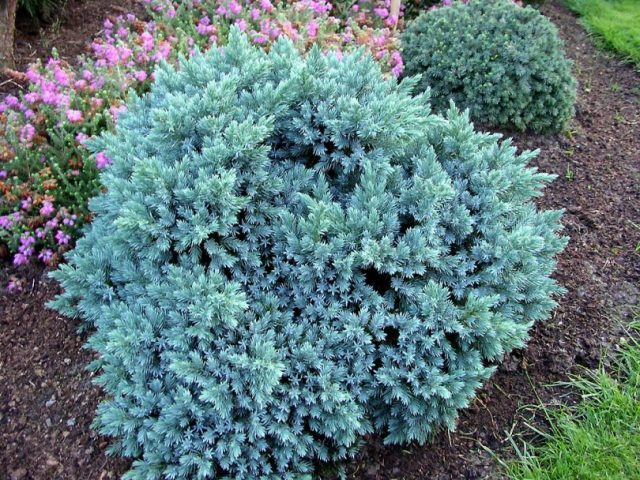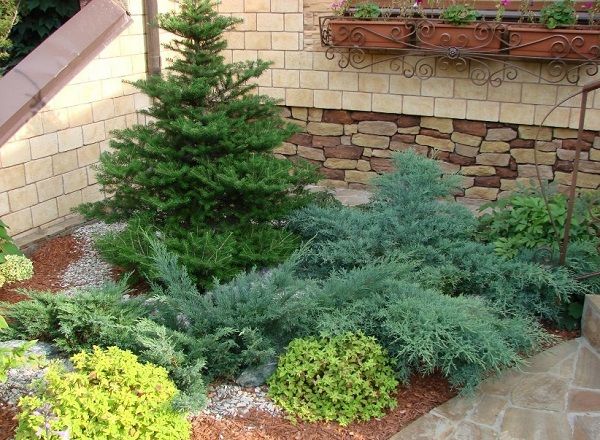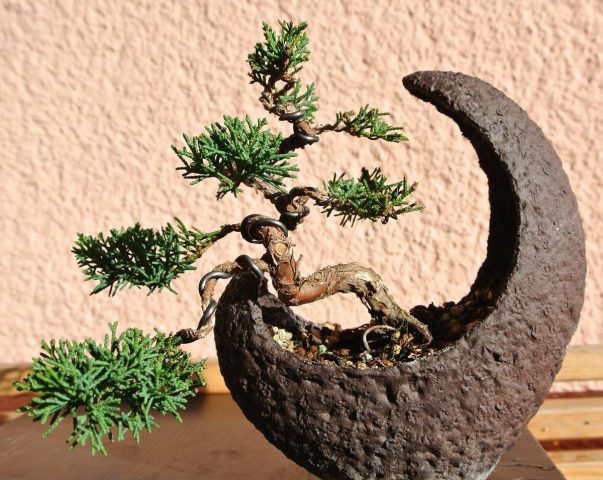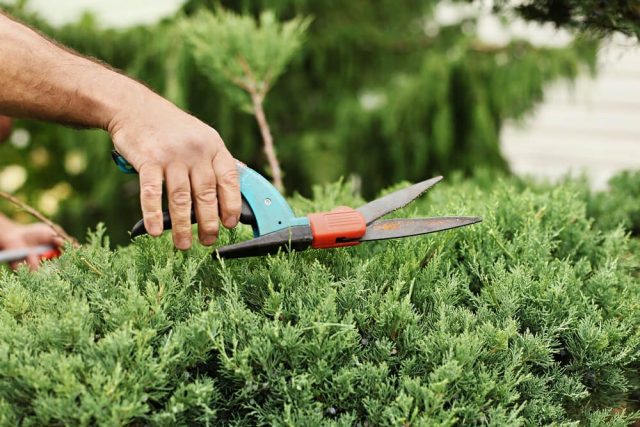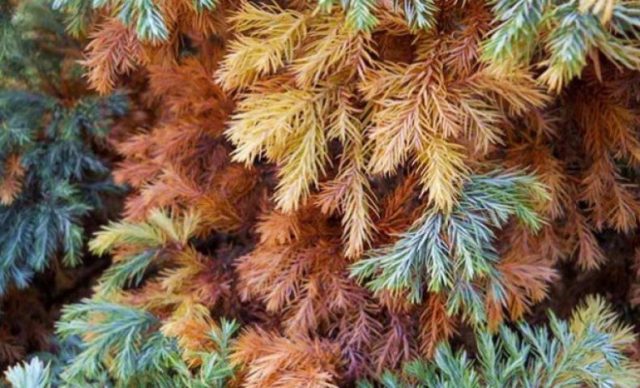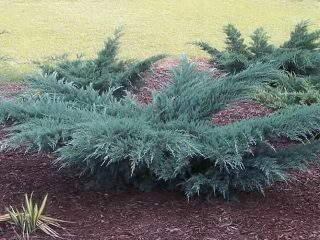Content
Among the dwarf shrubs there are representatives of conifers that take root in almost any climate. Blue Star juniper is an unpretentious plant with a spherical crown. The culture received its name for the unusual color of the needles - pale green with a smoky blue tint. This shrub with high decorative qualities can grow both in city parks and outside the city.
Description of juniper Blue Star
This is a low-growing shrub that grows several centimeters per year. Its numerous shoots are densely strewn with short, prickly needles. Young seedlings up to a year are spherical in shape, while an adult plant takes on the shape of a hemisphere or dome. Does not require additional shaping pruning.In spring and summer, juniper spines are smoky-gray and blue; in autumn and winter they turn purple.
A grown shrub with scaly, colored needles will become a wonderful decoration of the landscape. Possessing excellent decorative qualities, blue star juniper exudes a strong pine aroma. Its essential oil is believed to have phytoncidal and disinfectant properties.
Dimensions of juniper BlueStar
This plant is compact: the height of blue star juniper is no more than 70 cm, the diameter of the crown does not exceed 1.5 m. This species is classified as dwarf. The small size of the shrub is compensated by the density of the needles and the close arrangement of the branches; they form a lush crown.
Winter hardiness zone of juniper scaly Blue Star
The plant is considered winter-hardy. Recommended for cultivation in central Russia. In northern regions it requires shelter for the winter. It tolerates frost well under snow. Shrubs of the first year are covered for the winter even in the southern regions.
Annual growth of Blue Star juniper
This variety is slow growing, after planting, after 10 years its height will be only 50-70 cm, crown circumference - no more than 1.5 m. Juniper grows in height up to 5 cm per year, shoots add 10 cm in 12 months.
Is Blue Star juniper poisonous or not?
The plant is classified as a poisonous crop. When carrying out gardening work: pruning, fertilizing, watering, you must wear gloves. It is important to protect children and pets from contact with Blue Star juniper squamata.
Juniper Blue Star in landscape design
The lush branches of the bush allow you to create original compositions using it. The gray-blue shade of the needles looks advantageous against the background of other evergreen coniferous and deciduous crops.
This plant will fit well into the design of rockeries, rock gardens, and home lawns. Thanks to its compact size, Blue Star can be grown in pots and cache-pots, which will become a wonderful decoration for street window sills, balconies, and canopies.
In open areas and hillocks, low-growing varieties of juniper are used in combination with other creeping, rocky plants.
In the photo you can see how good several types of juniper look, including scaly Blue Sky, framing stone and brick buildings and stairs.
If you wish, you can grow or purchase bluestar juniper bonsai. This is a miniature, exotic, ornamental plant that can be used to decorate any design, not just outdoors. Bonsai is indispensable for landscaping loggias, roofs, terraces, and balconies. With its help you can create miniature landscape compositions in winter gardens and home premises.
This shrub is grown from seeds or cuttings. The seeds are obtained from dried and crushed juniper fruits. Cuttings are taken from a young plant whose bark has not yet become woody or brown. It is important to take into account that the germination of juniper seeds is weak, so you need to prepare a lot of them.
Planting and caring for Blue Star juniper
To root the crop, choose open areas well lit by sunlight. In the shade of buildings and tall plants, juniper becomes faded and loses its needles. In the absence of ultraviolet light, the Blue Star becomes similar to an ordinary wild juniper with pale green needles.For this ornamental crop, it is also important that the area is well ventilated.
Preparing seedlings and planting area
Blue Star juniper grows well and takes root on soils with any composition, except salty and overly moist ones. If the site is dominated by clay soils, the plant must be provided with high-quality drainage. You can also mix the soil with sand and peat in equal parts. Humus and clay are added to sandy and rocky soils.
Before rooting into the planting hole, seedlings must be in special pots or containers, the roots are protected and moistened. Before planting, the plant must be carefully removed from such a container.
Rules for planting juniper Blue Star
Blue Star juniper seedlings are planted in the spring. In order for them to grow well, it is necessary to maintain a distance of at least half a meter between several plants. Ideally, so that the shoots can stretch freely, when planting in groups, the distance between planting holes is 2.5 m.
Landing algorithm:
- First of all, dig a planting hole the size of which is larger than the rhizome.
- A layer of approximately 10-15 cm of pebbles or expanded clay is laid on the bottom. This material will serve as drainage.
- The next layer, at least 10 cm, is fertile, fluffy soil with the addition of peat and sand.
- The seedling is removed from the container along with a lump of earth, while the roots should not be damaged.
- After Blue Star is lowered into the planting hole, the roots are straightened.It is important to monitor the root collar: it should be above the ground or level with it.
- Sprinkle the juniper roots with a mixture of soil, sand and peat, taking them equally.
After planting, the plant is watered abundantly and the soil is mulched. A week after rooting, stop watering and add another small layer of soil under the soil.
Watering and fertilizing
Juniper juniperus squamata blue star needs watering only in summer, when there is no precipitation. 3 waterings per season are enough. Approximately a bucket of water is allocated for one bush. If the high temperature lasts for more than a month, the juniper needs spraying. The procedure is carried out in the evening, after sunset, once a week. If the climate zone where Blue Star grows receives sufficient summer precipitation, additional watering is not necessary. Excess moisture is detrimental to the Blue Star.
Fertilizer is applied to the soil in early spring, during the period of swelling of the buds. The soil is dug up with nitroammophos, about 15 cm away from the trunk, and then watered with Blue Star. In October you can also dig up soil with potash fertilizers.
Juniper over 2 years old does not need feeding. Growing on fertile soils saturated with microelements, the Blue Star loses its rounded crown shape, the shoots grow and lengthen. An adult Blue Star plant only needs watering, removal weed and loosening the soil.
Mulching and loosening
Juniper grows actively if there is air access to its roots. To do this, 2-3 times during the summer you need to carefully dig up the soil around the trunk of the bush.
It is important to regularly remove all weeds; pests can grow in their leaves. Afterwards, the soil can be sprinkled with complex fertilizer for coniferous crops and watered.Then the soil is mulched with wood chips, sawdust, and peat.
Cutting juniper Blue Star
In the fall, sanitary pruning of bushes is carried out. Remove dead, dry, damaged branches. During the procedure, attention is paid to parasites and diseases that can affect the plant. If there are signs of larvae or spotting, the damaged branches are removed and burned, and the bush is treated with special chemicals.
Blue star juniper does not need formative pruning. It acquires a rounded crown shape as it grows.
Preparing for winter
In late autumn, when the garden is being dug up, the soil around the juniper is also loosened. Afterwards it is covered with a 10-centimeter layer of peat to insulate the roots. The shoots are tied with loose rope or tape so that they can withstand the weight of the snow. Afterwards spruce branches are thrown over the bush to protect it from frost.
Reproduction of juniper Blue Star
This crop can be propagated by layering, seeds and cuttings. The seeds produce non-viable seedlings with weak decorative characteristics.
Cuttings can be obtained from an adult plant that is at least 5 years old. At the end of April or early May, strong branches with buds are selected. They are cut and divided into small pieces of approximately 15 cm. Then they are placed in a growth stimulator for a day. Afterwards the branch is rooted in a mixture of peat and sand.As soon as the roots appear, the seedlings are transferred to the garden plot.
Shrubs are often propagated by layering. They are secured with staples to the ground in several places. As soon as the roots appear, young Blue Star juniper plants are transplanted.
Pests and diseases of Blue Star juniper
All varieties of junipers suffer from rust. It affects the branches, red spots appear, and the bark in this area dries out and cracks. Damaged shoots are cut off and destroyed, and the bush is treated with special preparations.
In spring, fungal infections can be found on juniper needles. At the same time, the needles turn yellow and fall off. The shrub is sprayed with fungicides once every 7 days until the signs of the disease completely disappear.
Juniper Blue Star can be affected by scale insects, aphids, mites, and moths. As soon as their larvae appear on the shoots, the bushes are treated with insecticides until the pests are completely destroyed.
The appearance of pests and diseases of Blue Star juniper is not associated with care. Infection can occur from nearby garden crops.
Conclusion
Blue Star juniper is a beautiful ornamental plant that adapts to any climatic conditions. It can be grown in temperate climates and even in northern regions. With minimal expenditure of labor and money, you can achieve long-term landscaping of a site even with heavy soils on which it is difficult to grow other crops.
